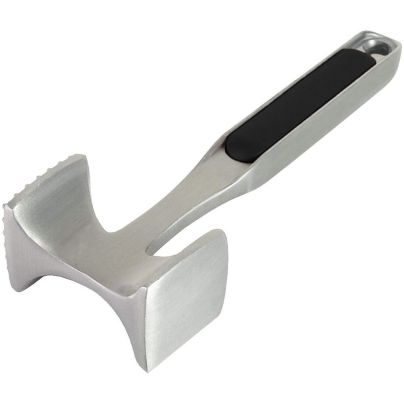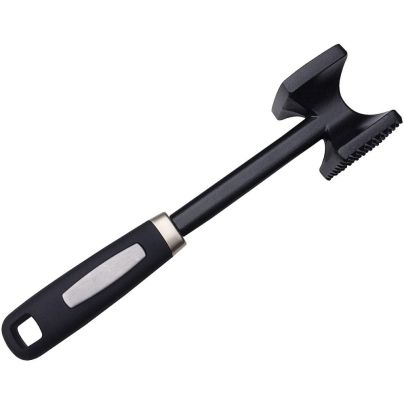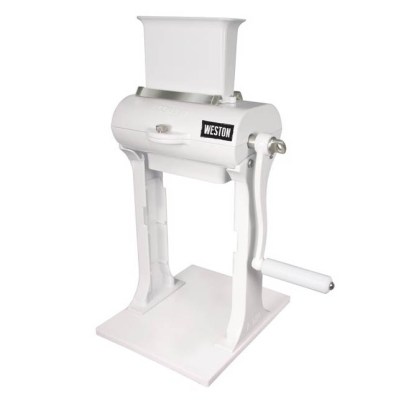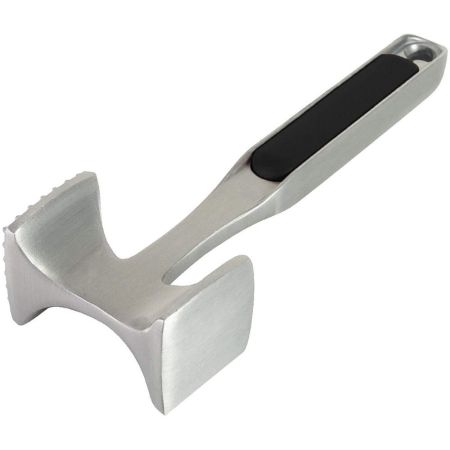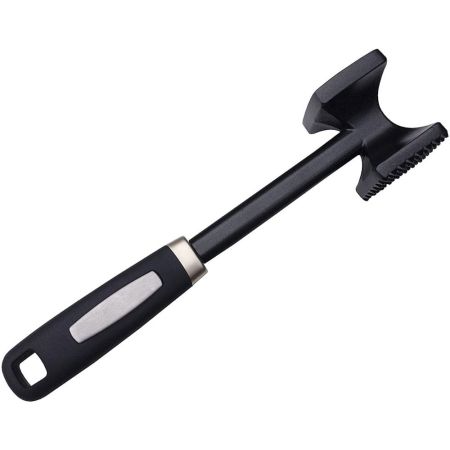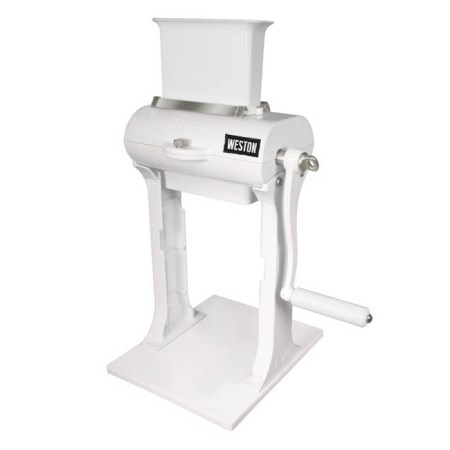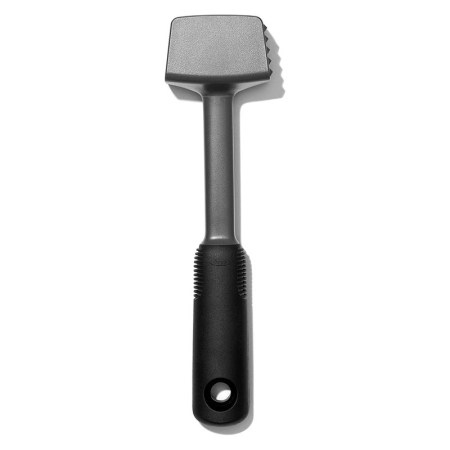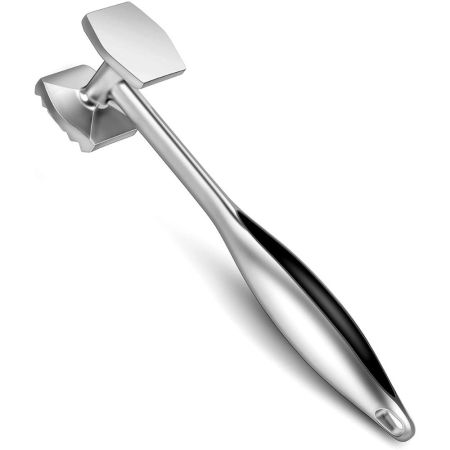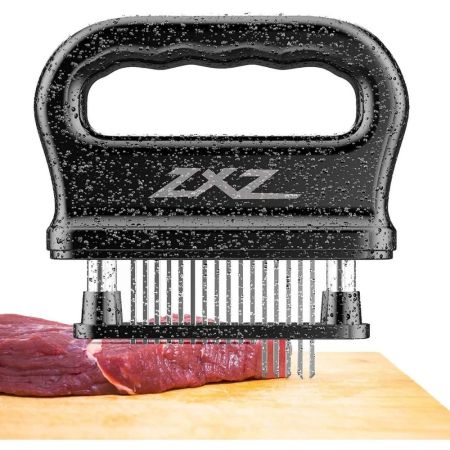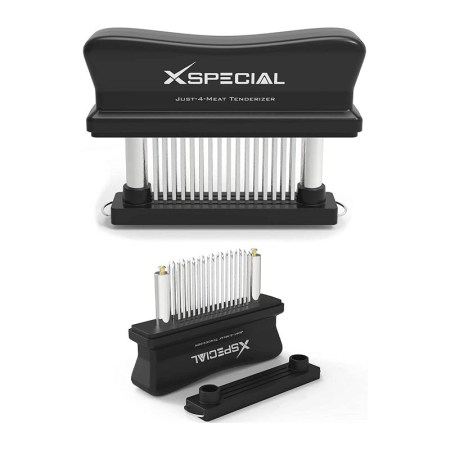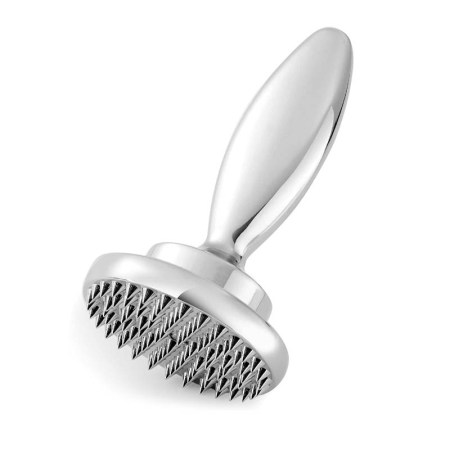We may earn revenue from the products available on this page and participate in affiliate programs. Learn More ›
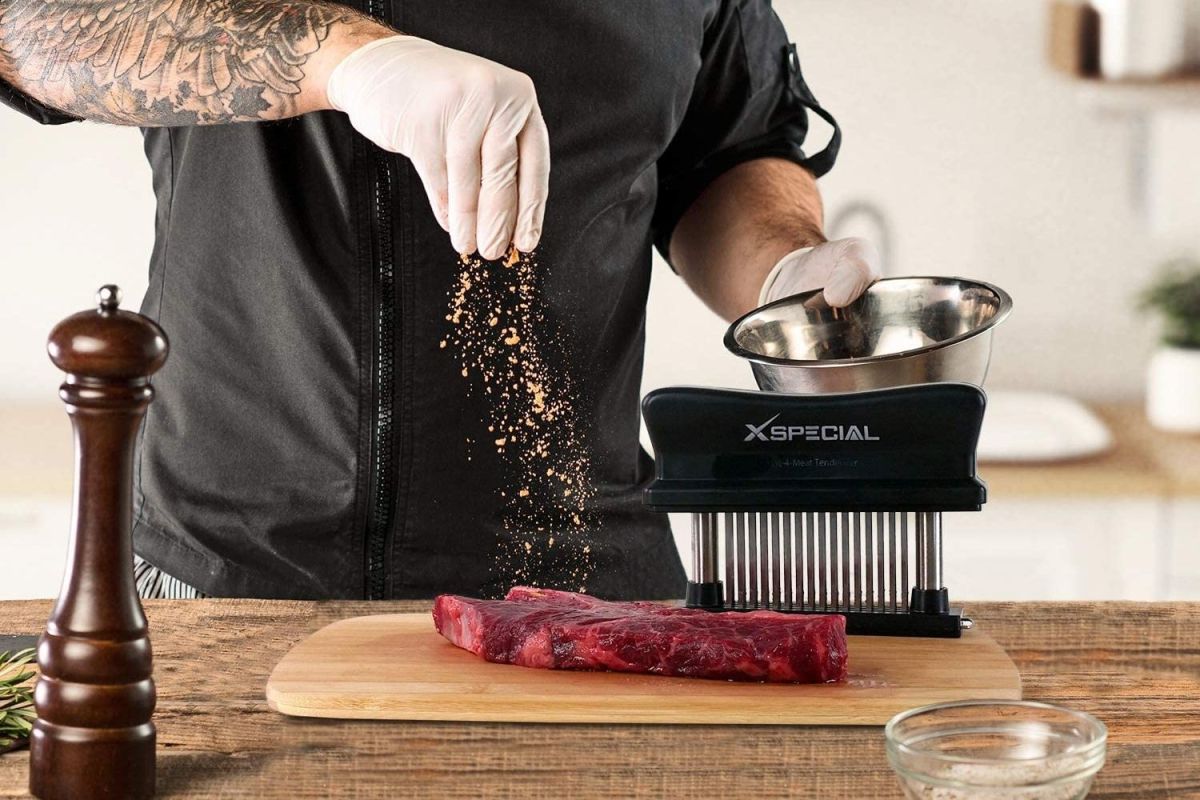
Whether you’re preparing a roast, steak, chicken, or any other type of meat, it should be succulent and tender. To ensure that your meat cuts meet your expectations, try a meat tenderizer. Meat tenderizers physically break down dense protein bonds, allowing moisture to easily permeate through the meat while it cooks.
Several factors go into choosing a meat tenderizer, including the size and thickness of the meat, the amount of counter space you have to work with, protective features to help you use the tenderizer safely, and more. Keep reading for tips on choosing the best meat tenderizer for better dishes—whether baked, grilled, or pan-fried.
- BEST OVERALL: KitchenAid Gourmet Meat Tenderizer
- BEST BANG FOR THE BUCK: Checkered Chef Meat Tenderizer
- UPGRADE PICK: Weston 2-in-1 Jerky Slicer & Cuber/Tenderizer
- MOST COMFORTABLE: OXO Good Grips Meat Tenderizer
- BEST MALLET: Aliglow Meat Tenderizer Hammer/Mallet Tool/Pounder
- BEST NEEDLE: ZXZ Meat Tenderizer, 48 Stainless Steel Sharp Needle
- BEST BLADE: XSpecial Meat Tenderizer Tool 48 Blades Stainless
- BEST POUNDER: KEISSCO Reversible Meat Tenderizer and Pounder
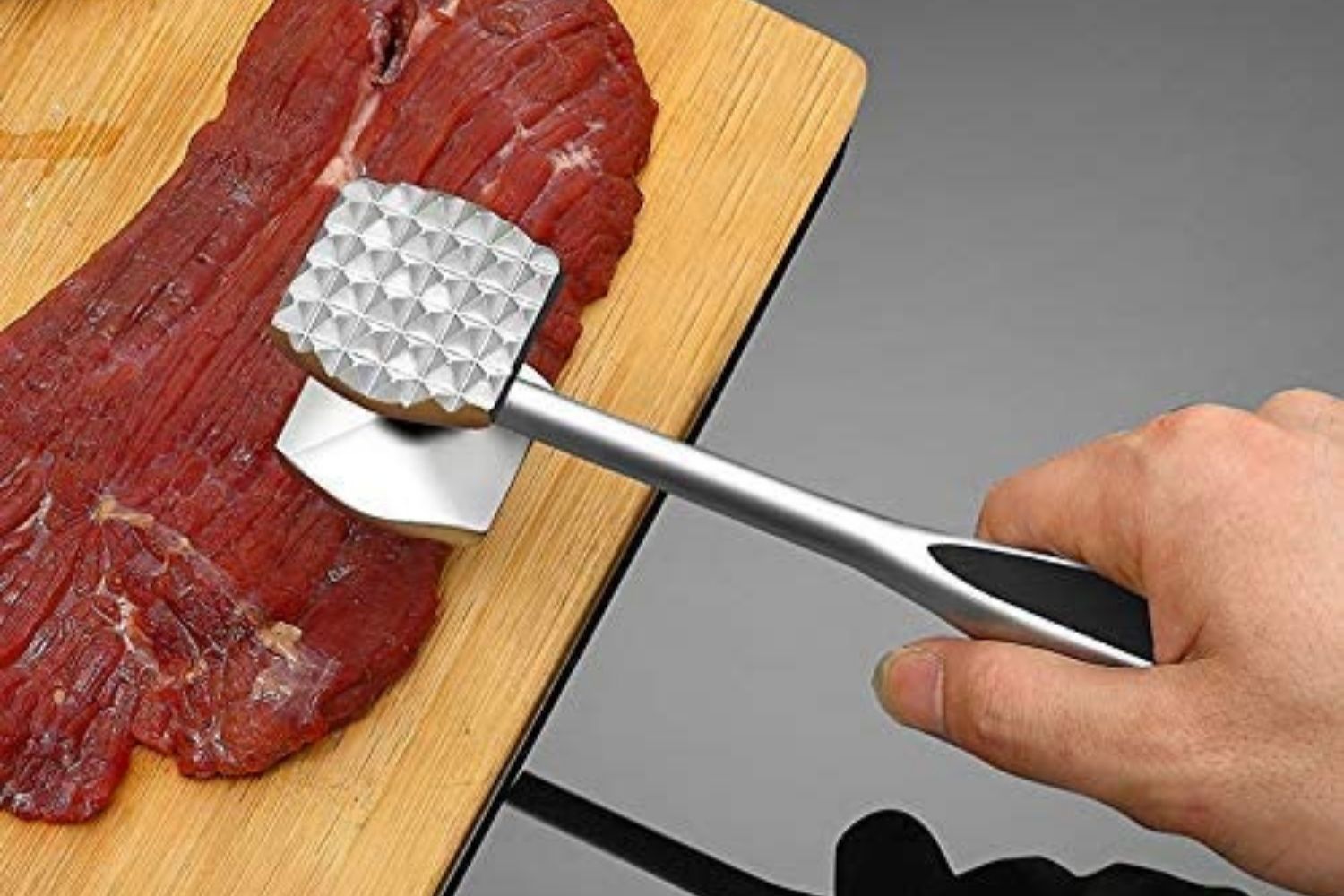
Types of Meat Tenderizers
Meat tenderizers fall into three categories: mallet, needle, or blade. A breakdown of each category follows.
Mallet
A mallet, or a meat hammer, is the most traditional tool used to tenderize beef, pork, and thick cuts of poultry. Mallets typically have two sides for tenderizing meat: One side features several small, pyramid-shaped points that are ideal for breaking apart the tough cuts and muscle fiber. The other side is smooth and flat and can be used to flatten the meat to give it an even thickness while it cooks.
These kitchen tools are effective and simple to use. Just choose a side and strike the meat with the mallet as if it’s a hammer. Remember: You’ll need enough space to swing the mallet without making a mess. You might want to wear an apron or cover your countertops, too. This is because the meat can splatter during tenderizing.
Needle
Needle meat tenderizers use a set of razor-sharp metal needles to pierce the meat to a depth of 1.5 to 2 inches. The needles tear apart muscle tissue and provide narrow channels for seasonings, rubs, and marinades to penetrate. These piercing cuts can also reduce cooking time since they help heat and moisture permeate through the muscle fibers.
Needle meat tenderizers are not suitable for thinner cuts of meat. This is because the piercing needles can tear the meat apart instead of simply tenderizing it. Some tenderizers also include safety features like retractable needles or a guard to prevent accidents.
Blade
Function-wise, blade tenderizers are similar to needle meat tenderizers. Blade tenderizers use a series of piercing blades to cut through the tissue of the meat to increase its tenderness while creating channels through which seasoning, rubs, and other flavors can permeate. Blade meat tenderizers have a wider cutting blade that is better suited to large, thick cuts of meat.
These tenderizers also share the same inherent risks that come with using needle meat tenderizers, so it would be best to invest in a product that offers safety features. Refer to the manufacturer’s directions to determine the best way to clean your tenderizer.
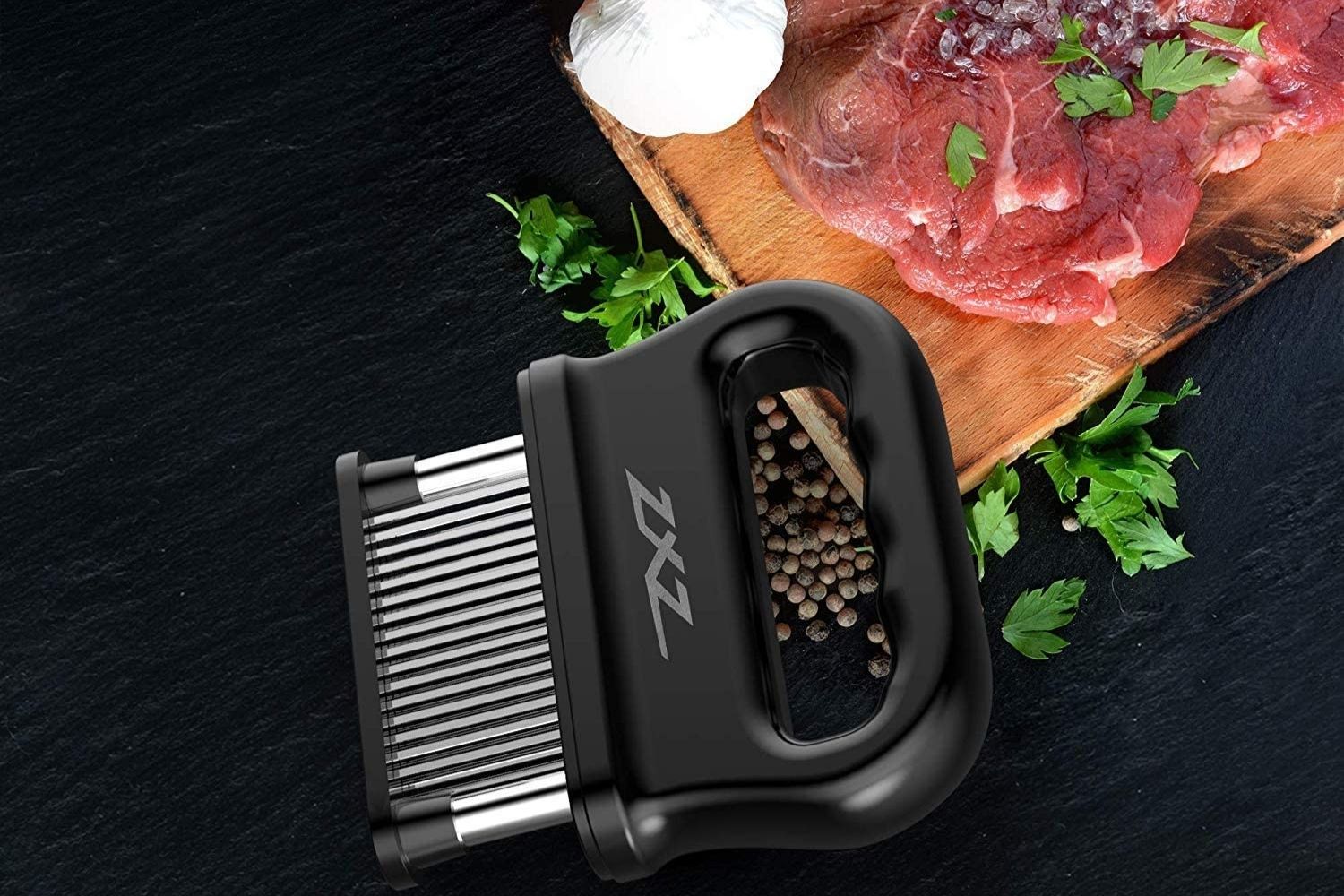
What to Consider When Choosing the Best Meat Tenderizer
Meat tenderizers come in a variety of shapes and sizes. Broad, heavy tenderizers are great for large cuts of meat, while smaller meat tenderizers are better for poultry and thin pieces of pork or beef. Consider whether you want a meat tenderizer that can go in the dishwasher or if you’re OK with hand-washing it. Keep the following other features in mind while shopping.
Material
A meat tenderizer is made for one purpose, preparing cuts of meat so that they cook more efficiently, taste better, and have a softer feel in the mouth, especially while chewing. With this in mind, most meat tenderizers are made of hard, durable materials like stainless steel, aluminum, and tough plastic.
- Stainless steel meat tenderizers are an excellent option for the kitchen because a stainless steel tenderizer resists water naturally. This metal is also known for its durability and stands out as one of the best options for tenderizing meat, regardless of whether the stainless steel goes into a mallet, needle, or blade tenderizer.
- Aluminum meat tenderizers aren’t as durable as stainless steel products, but they are more lightweight, making it easier to use an aluminum mallet on tough meat for a longer period of time. This metal is also water-resistant, and tenderizers made of aluminum can often be washed in the dishwasher.
- Plastic meat tenderizers are not as common as aluminum or stainless steel because plastic simply isn’t as durable. However, there are some inexpensive options that use plastic because it’s lightweight and can effectively tenderize meat. Some hard-plastic mallets also have steel cores to help improve the durability of the tenderizer.
Blades
The blades of a needle or blade meat tenderizer are another important factor to consider. Your blades should be durable and sharp to ensure maximum efficacy as a kitchen tool, which is why stainless steel blades are a great option. Weak blades are likely to break after you’ve used them several times or if you try to use them on a very tough piece of meat. If the blades are not sharp enough, then they can actually become stuck in the meat, ultimately requiring you to remove them.
You also should consider the number of blades on the meat tenderizer. The more blades, the easier it is to tenderize the meat. However, a large number of blades will tear apart smaller cuts of meat, so they’re not always appropriate.
Handle
The handle of the meat tenderizer should have an ergonomic design that fits your hand. This way, you’ll have the best control possible while tenderizing. You also can opt for a tenderizer with a comfortable grip—an especially important feature for mallets.
Needle and blade meat tenderizers typically have handles that are built into the body of the tenderizer. To use them, just grab and press down. Mallet handles extend out horizontally from the head of the meat tenderizer and are typically made to swing the head of the mallet on an arc, with your hand acting as the fulcrum.
Some mallets (called pounders) have vertical handles and can be used to tenderize meat with a downward motion of your clenched fist. Additionally, some tenderizers function more like a grinder, so the meat is slowly crushed between two wheels that the user turns with a hand-crank handle.
Safety
When you’re using a kitchen tool that’s designed to damage and tenderize meat, you need to be very careful to ensure that you don’t hurt yourself. Some simple safety features that can help prevent injuries include retractable blades, blade locks, and guards.
- Retractable blades are a common feature on most needle and blade meat tenderizers, though some manual products still are available. This feature ensures that the blades retract into the tenderizer when pressure is no longer being applied.
- Blade locks keep the blades or needles locked in place. This includes locking them in the tenderizer so that accidental pressure doesn’t push them out, but it can also lock them in the out position if you need to tenderize quickly.
- Guards can be used on all types of meat tenderizers and are typically made of durable plastic that fits neatly over the blades or the pointed head of a mallet.
Maintenance
Another aspect that’s easily forgotten is how you should clean, dry, and store a tenderizer. Most mallets and some needle and blade meat tenderizers are dishwasher safe. Before you put anything into the dishwasher, you should ensure that the gaps between the blades, needles, and pyramid-shaped points are free of debris, including tiny pieces of raw meat.
Wash meat tenderizers that cannot go in the dishwasher by hand using a durable brush. This helps remove any remaining pieces of food and protects your hands from accidental cuts. Some products even come with a specially designed brush that perfectly fits the size and shape of the blades, needles, or points.
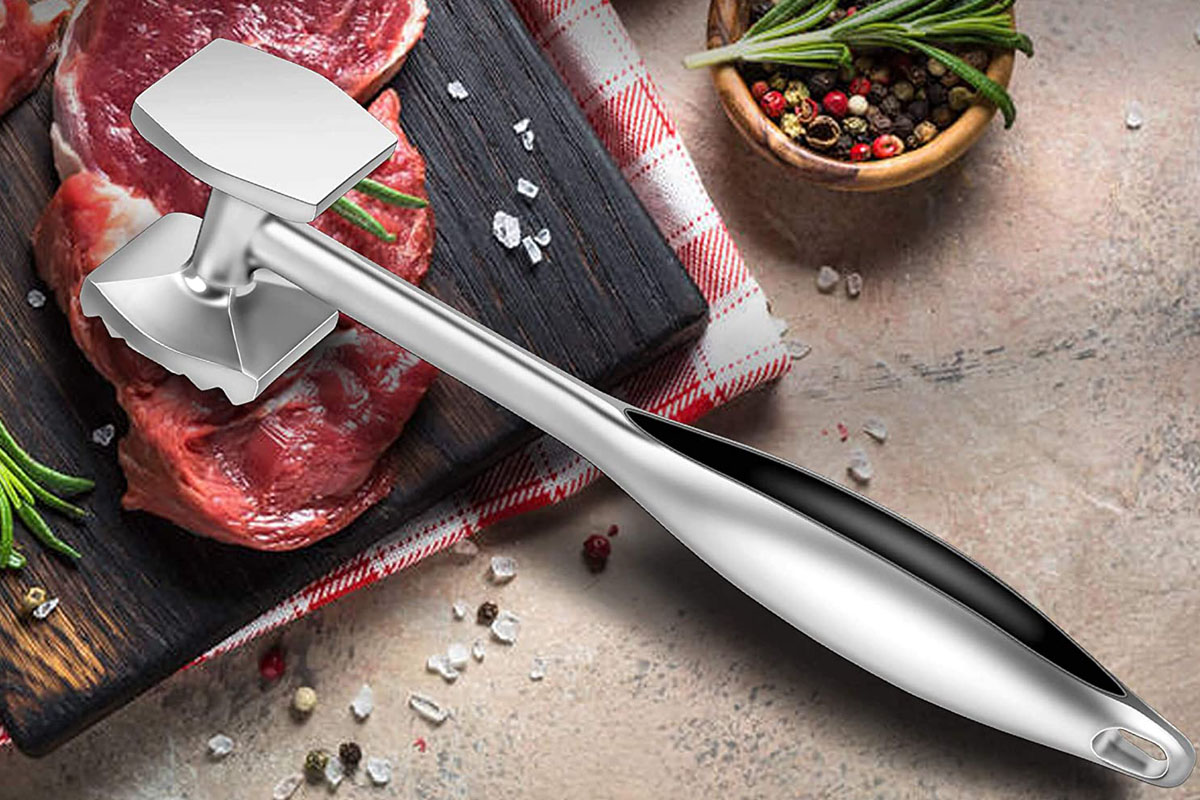
Our Top Picks
Now that you’re better informed about the features of meat tenderizers, check out the top picks below to find a new addition to your kitchen arsenal.
Best Overall
KitchenAid Gourmet Meat Tenderizer
See ItImprove the quality, texture, and even the taste of your food with this impressive mallet meat tenderizer. It’s made with a durable (and lightweight) aluminum construction that won’t break after repeated use. One side of the mallet has a flat face and can be used for flattening meat or alternative cooking purposes, like crushing nuts or ice.
The textured side of the KitchenAid meat tenderizer has several rows of sharp spikes that can easily cut through the tissues and tenderize your food. It also has a hole in its handle for easy storage. Don’t wash this mallet in the dishwasher. Instead, scrub the spikes with a soft brush. Wash the rest of the mallet with your hands or a cloth before drying it and putting it away.
Product Specs
- Type: Mallet
- Material: Aluminum
- Handle: Horizontal
Pros
- Lightweight and durable
- One textured and one flat mallet face
- Nonslip handle
- Built-in hanging hole for convenient storage
Cons
- Hand-wash only
Best Budget
Checkered Chef Meat Tenderizer
See ItThe Checkered Chef tenderizer has a sleek black design and an aesthetic appeal that can help give your kitchen a more modern appearance. Use the flat side or the spiked side of this mallet meat tenderizer to prepare your food for the frying pan, oven, or grill, and experience the difference a tenderizer can make in the taste, texture, and overall quality.
This meat tenderizer has an ergonomic handle that’s wrapped in nonslip rubber, so you won’t have to worry about it slipping from your hand. It’s also made so that both left- and right-handed individuals can use the mallet without a problem. When you’re done, just rinse it off and then put it in the dishwasher for easy cleanup.
Product Specs
- Type: Mallet
- Material: Aluminum
- Handle: Horizontal
Pros
- Lightweight aluminum construction
- Rubberized handle absorbs shock waves while hammering
- Multipurpose with both a flat and textured side
- Dishwasher safe
Cons
- Aluminum shaft does not extend into the handle
Upgrade Pick
Weston 2-in-1 Jerky Slicer u0026 Cuber/Tenderizer
See ItThe Weston slicer/cuber is an incredibly efficient tool for tenderizing entire cuts of meat without having to swing a mallet or pierce through tough meat with a needle or blade tenderizer. That being said, it is a bulky product that can be difficult to set up and clean. The meat tenderizer comes with 31 stainless steel blades that rotate within the unit when a user turns the hand-crank handle.
Simply feed the cut of meat into the blades through the top feeder tray and turn the hand-crank until the meat comes out of the bottom of the tenderizer. To help stabilize the tenderizer, users can mount it to the counter or a table with the included C-clamps. It even comes with a set of stainless-steel tongs to grab the meat as it’s coming out of the tenderizer, to keep cooks from risking getting their fingers near the blades.
Product Specs
- Type: Specialized meat cuber tenderizer
- Material: Stainless steel
- Handle: Hand crank
Pros
- 31 stainless-steel blades tenderize the meat
- Simple hand-crank function
- Can be mounted to the counter
- Comes with stainless steel tongs
Cons
- Heavy and difficult to move
- Tough to clean
Most Comfortable
OXO Good Grips Meat Tenderizer
See ItThe OXO meat tenderizer is made with BPA-free, impact-resistant ABS plastic, and it features a stainless steel core to increase the tool’s striking strength and durability. The angles of the mallet faces have been optimized to improve the ability of the textured face to break up tough muscle fibers and increase the flattening efficiency of the flat mallet face.
This mallet weighs only 6 ounces, mostly because of its outer plastic construction. While this is beneficial for reducing user fatigue, plastic does not typically last as long as stainless steel or aluminum in this sort of tool. Users can quickly clean this mallet by putting it into the dishwasher, though it is recommended to rinse the textured face of the mallet thoroughly before it goes into the dishwasher to ensure removal of any stuck pieces of meat.
Product Specs
- Type: Mallet
- Material: Plastic and steel
- Handle: Horizontal
Pros
- Strong steel core
- Lightweight at just 6 ounces
- Dishwasher safe
- Optimized mallet head angle for efficient tenderizing
Cons
- Plastic is not as durable as metal
Best Mallet
Aliglow Meat Tenderizer Hammer/Mallet Tool/Pounder
See ItThis mallet meat tenderizer is double-sided so that you can flatten your meat with one side and tenderize it with the other. The tenderizer is made of a single piece of solid alloy steel, so you won’t have to worry about it breaking after repeated uses. It also washes safely in the dishwasher; just be sure to rinse it off first.
The handle has a smooth, rounded shape that makes it easy to hold and allows for comfortable use regardless of your handedness. The handle also has a cushioned surface to help absorb the impact from strikes and to create an anti-slip surface so the tenderizer won’t slip out of a user’s hand.
Product Specs
- Type: Mallet
- Material: Stainless steel
- Handle: Horizontal
Pros
- Ergonomic, nonslip handle
- High-durability, full-metal construction
- Balanced mallet head with flat and textured sides
Cons
- Heavier than aluminum or plastic mallets (10.5 ounces)
Best Needle
ZXZ Meat Tenderizer, 48 Stainless Steel Sharp Needle
See ItThe needles of this meat tenderizer have been sharpened to a razor point so that they pierce the meat with very little effort when a user applies pressure to the handle. The needles can then retract into the tenderizer, reducing the risk of cuts and keeping you safe while you prepare your meal. The handle of this meat tenderizer has a grip that’s easy to hold firmly and apply even pressure so that you have full control while you’re tenderizing the meat.
When you finish with the tenderizer, easily remove the bottom to properly clean the exposed needles. This product comes with a cleaning brush to help you remove any remaining meat from the blade or the base of the tenderizer. Once the initial scrub is done, you can hand-wash the tenderizer or put it into the dishwasher. It also comes with a protective cover so you can store it safely until you use it again.
Product Specs
- Type: Needle
- Material: Stainless steel
- Handle: Built-in
Pros
- Easy to pierce meat with the extra sharp needles
- Comes with a protective cover
- Dishwasher-safe tool
- Needles can be removed for thorough cleaning
Cons
- Not suitable for thin cuts of meat
Best Blade
XSpecial Meat Tenderizer Tool 48 Blades Stainless
See ItInstead of relying on a mallet tenderizer, you can use this 48-blade meat tenderizer to quickly and efficiently cut narrow slices into the meat. The blades of the tenderizer pierce the meat when you apply pressure to the handle. After the pressure is relieved, the blades retract into the tenderizer so you don’t accidentally cut yourself.
This tenderizer has a smooth, contoured handle that’s easy to grip and operate with just one hand using a simple up-and-down motion. This method also reduces the cooking time by up to 40 percent. When you’re done, you can either wash it by hand or put it in the dishwasher.
Product Specs
- Type: Blade tenderizer
- Material: Stainless steel
- Handle: Built-in
Pros
- Can reduce cooking time by up to 40 percent
- Retracting blades help prevent accidental injury
- Dishwasher safe
Cons
- Not suitable for thin cuts of meat
Best Pounder
KEISSCO Reversible Meat Tenderizer and Pounder
See ItThe KEISSCO meat pounder has a vertical handle for use in a straight downward motion (as if you were pounding your fist onto the surface of the counter). The handle has a smooth chrome coating with a zinc core that is dishwasher safe, though the manufacturer notes to first remove the rubber gasket.
This meat tenderizer has a base shaped like a disk. The disk can be switched from a flat side for flattening meat to a spiked side for tenderizing. The flat side of this tenderizer can also be effectively used to crush cookies, crackers, cereal, nuts, and other foods typically called for in cooking or baking recipes.
Product Specs
- Type: Mallet pounder
- Material: Zinc with chrome plating
- Handle: Vertical
Pros
- Reversible tenderizer head
- Full-metal construction
- Dishwasher safe
Cons
- Downward stamping motion is odd for some users
- Smooth handle is vulnerable to slipping
Our Verdict
Quickly and effectively break apart tough muscle fibers to improve the quality of your steak with the KitchenAid tenderizer. Or, opt for the budget-friendly Checkered Chef tenderizer with a nonslip grip, which helps ensure that the tool doesn’t slip out of your hand mid-swing.
How We Chose the Best Meat Tenderizers
When it came to selecting the top products, it was necessary to first examine many types of meat tenderizers and any specialized variations on these products. This ensured that we had a comprehensive idea of the available products within this category. Our knowledge was furthered through extensive research into individual products and helped to determine the best meat tenderizers within their given categories.
Key factors that contributed to this selection included the type of meat tenderizer, the material each tenderizer was made from, the type and form of the handle, and whether the products had any features that made them stand out from similar products, like a unique dishwasher-safe design without any concern about premature material failure.
In general, products that demonstrated a high degree of durability and reliability were considered top options, given that repeatedly hitting cuts of meat puts significant physical strain on these tools.
FAQs
Q: What is the best way to tenderize meat?
Whether you choose to tenderize with a mallet, needle, or blade tenderizer is up to you. Mallet tenderizers break the tough muscle fibers apart through repeated blunt force impacts with sharpened teeth that pierce through the surface of the meat. Needle and blade tenderizers both function by slicing into a cut of meat and breaking up tough fibers with a series of sharpened needles or blades.
While each of these tenderizers is effective with medium to large cuts of meat, it should be noted that both needle and blade tenderizers are a poor choice for thin cuts of meat because they may simply tear the meat apart instead of tenderizing it.
Q: What should I put on meat to help tenderize it?
To tenderize meat, you can use naturally occurring enzymes present in several popular fruits, including papaya, pineapple, and kiwifruit. You can also use vinegar, wine, lemon juice, buttermilk, and yogurt.
Q: What can I use instead of a meat tenderizer?
If you don’t have a meat tenderizer on hand, then you can use heavier items in your kitchen to serve as a makeshift tenderizer. These items could include a rolling pin, a thick wine bottle, a pot, or a heavy pan. However, keep in mind that none of these items will perform as well as an actual meat tenderizer.
Q: What other methods are used to tenderize meat?
You can tenderize meat by marinating it in acidic solutions, like lemon juice, lime juice, or vinegar. You could similarly marinate it in natural enzymes found in papaya juice, pineapple juice, and kiwifruit. If you don’t want to marinate the meat, then you can use a slow cooker to gradually break down the tough bonds between the muscle fibers over a long period at low heat.
